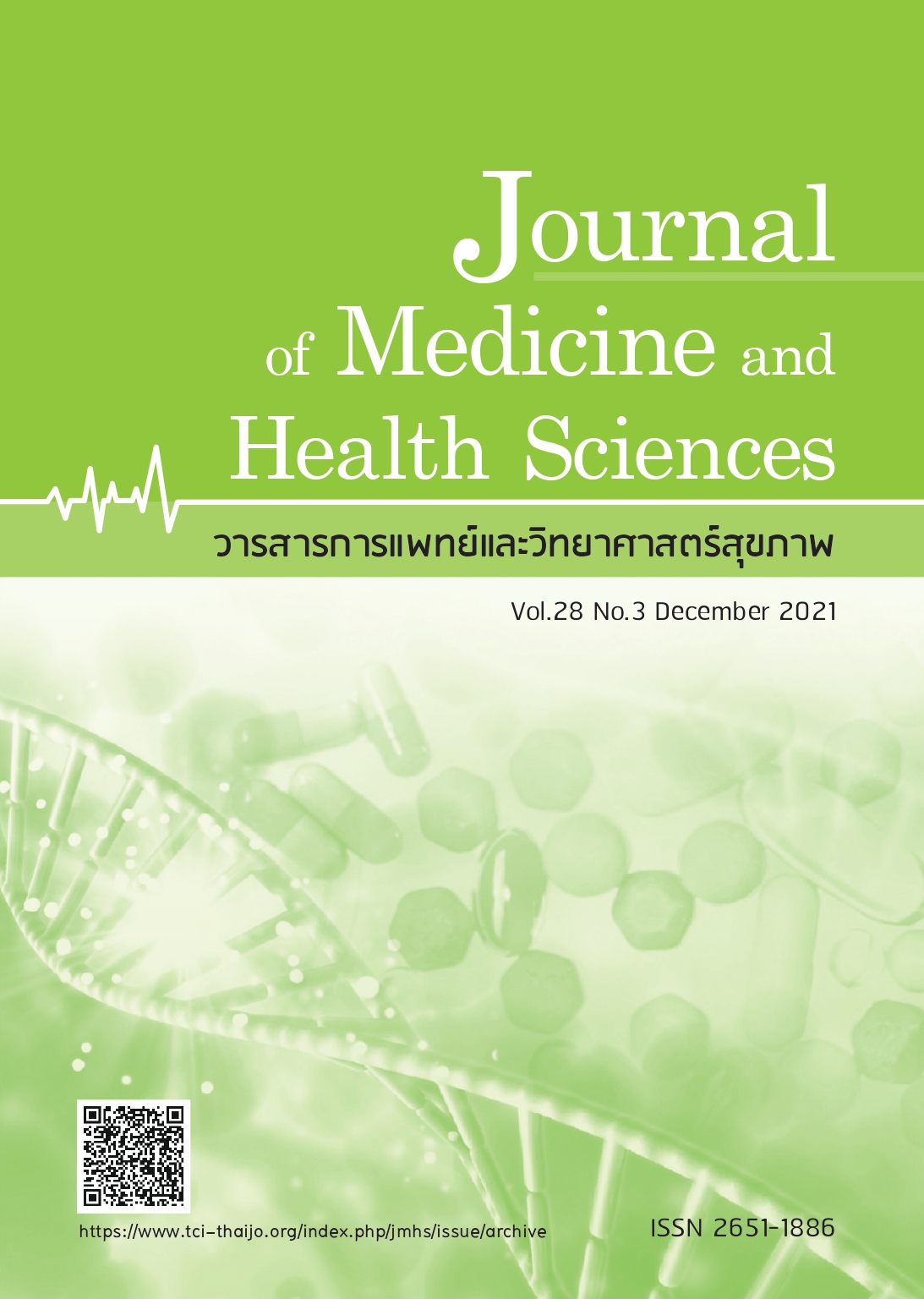Effects of Lom-Pa-Kang Steam Inhalation on heart rate variability in people with stress
Keywords:
Lom-Pa-Kang Steam Inhalation, stress, heart rate variability, steam inhalationAbstract
Abstract
Stress is one of the factors that cause imbalances in the autonomic nervous system. The purpose of this research was to study the effects of Lom-Pa-Kang Steam Inhalation (LPKSI) on the autonomic nervous system function in stressful conditions by measuring heart rate variability among participants with moderate to severe stress levels. The 60 participants were divided into two groups of 30 people, consisting of control and LPKSI groups. The participants in each group received 30-minute of treatments combined with stress stimulation by using mental arithmetic tasks. The heart rate variability was measured and compared during the period of pre-treatment, immediately after treatment, and after 10 minutes of treatment. The study found that after the participants inhaled LPKSI, the low frequency (LF) value decreased and significantly different from the control group (p-value < 0.05). In addition, the low frequency/high frequency ratio (LF/HF ratio) decreased immediately after treatment and 10 minutes after the treatment group (p-value < 0.05). However, no difference was found in LF value and LF/HF ratio between immediate results and 10 minutes after treatment (p-value > 0.05). This study demonstrated that LPKSI was effective in altering the heart rate variability of the participants under stressful conditions. It decreased the activity of the sympathetic nervous system, and the autonomic nervous system was involved in stimulating the heart to beat faster when the body is stressed or excited.
References
2. Khrisanapant W, Sengmeuang P, Pasurivong O, et al. Modulation of cardiac autonomic control in children and adolescents with obesity. Srinagarind Med J 2011;26:136-43. (In Thai)
3. Sztajzel J. Heart rate variability: a noninvasive electrocardiographic method to measure the autonomic nervous system. Swiss Med Wkly 2004;134:514-22.
4. Achanupap S. Textbook of treatment for general diseases Vol.2:350 diseases, care and prevention. 4th ed. Bangkok: Holistic Publishing; 2551. p.916. (In Thai)
5. Royal Institute. Thai medical and Pharmaceutical dictionary Royal Institute edition. 3rd ed. Bangkok: Department for Development of Thai Traditional and
Alternative Medicine; 2556. p.566. (In Thai)
6. Foundation for the rehabilitation of Traditional Thai Medicine. Textbook of traditional Thai medicine (Medical aid, Conservation edition). Bangkok: Supawanit Printing; 2550. p.485. (In Thai)
7. Luang-In V. Aromatherapy from essential oils. Burapha Science Journal 2018;23:61-78.
8. Kawai T, Kinoshita K, Koyama K, et al. Anti-emetic principles of Magnolia obovata bark and Zingiber officinale rhizome. Planta med 1994;60:17-20.
9. Sheriff O, Olatubosun T, Okesina K, et al. The effect of Zingiber Officinale (Ginger) extract on blood pressure and heart rate in healthy humans. IOSR JDMS 2014;13.
10. Arya DS, Arora S, Malik S, et al. Effect of Piper betle on cardiac function, marker enzymes, and oxidative stress in isoproterenol-induced cardiotoxicity in
rats. Toxico Mech Methods 2010;20: 564-71.
11. Wuthithammawet W. Encyclopedia of Thai herbs and medicinal plants for therapeutic use. Bangkok: Odeon Store; 1997. (In Thai)
12. Thongpila S, Sompee P. The effectiveness of mental development program to stress-reduction in nursing students when preparing for the nursing license
examination of thailand nursing and mid wife council. JONAE 2014:64-77.
13. Pitisutitham P, Pichiensunthorn CH, editors. Textbook of clinical research (fourth edition revised and expanded). 4th ed. Bankkok: Amarin Printing & Publishing;
2018. p.660. (In Thai)
14. Whitehead AL, Julious SA, Cooper CL, et al. Estimating the sample size for a pilot randomised trial to minimise the overall trial sample size for the external pilot and
main trial for a continuous outcome variable. Stat Methods Med Res 2016;25:1057-73. doi: https://doi.org/
10.1177/0962280215588241.
15. Vella EJ, Friedman BH. Hostility and anger in: Cardiovascular reactivity and recovery to mental arithmetic stress. Int J Psychophysiol 2009;72:253-9.
16. Thayer JF, Ahs F, Fredrikson M, et al. A meta-analysis of heart rate variability and neuroimaging studies: Implications for
heart rate variability as a marker of stress and health. Neurosci Biobehav Rev 2012;36:747-56.
17. Stein PK, Bosner MS, Kleiger RE, et al. Heart rate variability: A measure of cardiac autonomic tone. Am Heart J 1994;127: 1376-81.
18. Chandler NJ, Greener ID, Tellez JO, et al. Molecular architecture of the human sinus node: insights into the function of the cardiac pacemaker. Circulation 2009;
119:1562-75.
19. Yaribeygi H, Panahi Y, Sahraei H, et al. The impact of stress on body function: A review. EXCLI J 2017;16:1057-72.
20. Moss M, Oliver L. Plasma 1,8-cineole correlates with cognitive performance following exposure to rosemary essential oil aroma. Ther Adv Psychopharmacol
2012;2:103-13.
21. Kitamoto T, Kosuge T, Suzuki Y, et al. Effects of ginger aroma under stress conditions: A biometric perspective. Proceedings of International Forum on
Medical Imaging in Asia. 2019; 27 March; Singapore. 110500J. doi: https://doi.org/ 10.1117/12.2519704.
22. Singh V. Ethnobotany and Medicinal Plants of India and Nepal Vol.3. Scientific Publishers; 2009. p.315.
23. Karak S, Acharya J, Begum S, et al. Essential oil of Piper betle L. leaves: Chemical composition, anti-acetylcholinesterase, anti-β-glucuronidase and cytotoxic properties. J Appl Res Med Aromat Plants 2018;10:85-92.
24. Fink G. Stress Science: Neuroendocrinology. Academic Press; 2010. p.811.
25. Raffai G, Kim B, Park S, et al. Cinnamaldehyde and cinnamaldehyde-containing micelles induce relaxation of isolated porcine coronary arteries: role of nitric oxide and calcium. Int J Nanomedicine 2014;9:2557-66.
26. Dobetsberger C, Buchbauer G. Actions of essential oils on the central nervous system: An updated review. Flavour Fragr J 2011;26:300-16.



